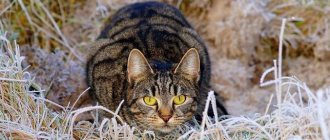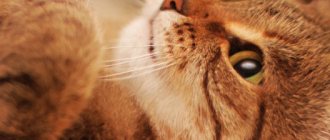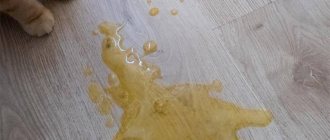Animals experience stress just like people, and often to a greater extent. The environment, unexplained events, and a banal move can have a detrimental effect on the pet, as they are difficult to withstand nervous overload.
Stress in a cat, like stress in a cat, is not always noticeable, since these animals are able to suppress their emotional state and not show off their fears and worries with dignity. Therefore, the owner’s task is to know the behavior of his pet down to the smallest detail in order to notice oddities in behavior in time and provide support and the necessary assistance.
The danger of stress
Despite the fact that cats seem to be quite independent animals, their lives are closely connected with the actions of their owner. The animal periodically has to be exposed to any stress factors.
The cat needs a bath, a haircut or a trip to the veterinarian, but she cannot understand that these are mandatory procedures, and in most cases they will not harm her. She, of course, is not able to understand that people move or die, and sometimes they can simply abandon their pet on the street. Cats become attached to both people and places of residence, they worry, experience emotions, and their range is almost as wide as that of a person.
The cat's nervous system reacts to negative circumstances instantly. Acute stress has physiological manifestations. These are:
- increased pulse and heart rate;
- fast and shallow breathing;
- high blood pressure.
Stress primarily affects the cat's nervous system.
Such symptoms are associated with a sharp release of stress hormones. The nervous system is able to cope with an acute condition, but with prolonged exposure the cat can fall into a chronic depressed state. The animal's cardiovascular system changes, digestive processes are disrupted, and immunity decreases.
What is stress and what are its consequences?
When any irritating factors begin to affect the body, the reaction follows immediately. Negative suppression of the nervous system and a state of tension lead to disruption of the psycho-emotional background, its disorder and changes in behavior. A sharp surge of irritation leads to an acute state of stress, and a regular negative effect on the central nervous system leads to a chronic feeling of depression.
When a pet begins to feel unhappy, its body begins to express this in various ways:
- There is an increase in blood pressure.
- Immune functions decrease.
- Breathing becomes rapid.
- Resistance to disease weakens.
- Heart rate increases.
- The functioning of the gastrointestinal tract is disrupted.
In an acute condition, such symptoms are not dangerous for the animal, will not leave consequences and will go away quite easily. But the chronic course of stress can lead to serious complications, provoke physical and psychological exhaustion, and can even take away a significant part of the tailed pet’s life.
The most common stressors
There are a number of reasons that cause stress in any cat at any age, regardless of its other physical parameters.
Diseases and physiological causes
A cat’s illness immediately affects its emotional state. Any problems in the body make you feel vulnerable. The stronger the symptoms of the disease, the higher the stress level.
The most common physiological stressor is parasites.
Helminth infestation causes indigestion and deficiency of nutrients and vitamins. If fleas, subcutaneous parasites appear, or the cat catches a tick, itching, pain, discomfort, and in some cases severe weakness are felt. In such a situation, the pet experiences irritation from itchy skin and weakness. Ticks can also cause serious infections.
Illness or discomfort causes emotional discomfort
Fungal diseases also cause significant discomfort. The feeling of one’s own weakness deprives one of confidence in safety and the ability to fight for one’s life.
Pain of various types, especially acute and aching, causes no less stress in the cat. The cause may be injury, surgery, or unsuccessful mating.
Emotional factors
Psychological causes of stress are the most difficult to diagnose. If the animal is outwardly healthy, there are no other external negative influences, but there are signs of anxiety and stress, then it is necessary to analyze the situation in the house and your own behavior. You need to take time and find out what exactly the cat is having a negative reaction to.
The main causes of psychological problems may be the following:
- death of a family member;
- change of owner;
- difficult atmosphere in the house, conflicts between people;
- feeling of uselessness and loneliness;
- lack of attention, manifestation of jealousy;
- fear or phobia.
Calm, non-conflict relationships in the house are important for a cat.
External factors
Any changes in their daily routine cause discomfort for cats. They can be designated as external factors. They are the most common group of causes of stress in cats.
Negative external influences include a trip to the veterinary clinic. Leaving the safety of your home is very stressful. The cat is placed in a carrier and it leaves its comfort zone. Not everyone tolerates travel well, so for many pets this is another reason for concern. Then the cats find themselves in an unfamiliar room filled with strange, highly irritating odors, and strangers begin to touch her.
When performing medical procedures, especially unpleasant ones, the animal begins to experience real panic. Sometimes, after a visit to the veterinarian, your cat may begin to lose hair.
Traveling to an unfamiliar place causes stress for a cat
Visiting a cat groomer is also a stress factor. Carrying and traveling again. Plus, there are unpleasant procedures. Especially when the cat visits such places quite rarely. A pet that is unaccustomed to grooming and washing will become very stressed.
A stress factor, as a rule, is the departure of the owner or the overexposure of the animal. Many owners do not have the opportunity to take their pet with them, for example, on a business trip or on vacation. Some people simply do not want to expose their animal to stress, especially if it suffers from seasickness and does not tolerate travel well. And if it is necessary to leave, the cat is given to friends, relatives or people who professionally care for animals. The latter are the most preferable solution, since such people find out the pet’s habits and routine and try to provide her with the most comfortable conditions. In any case, a change of place, new smells, a change in the usual daily routine is stressful for a cat. In addition, she does not understand that this is temporary, and may have a hard time worrying about it.
A change in the usual environment and people around frightens the cat
The arrival of a new family member or another pet can make the animal worry. Cats can be jealous, feeling that they are not getting enough attention. The birth of a child is easier for her to bear, but finding methods of communication with another animal is much more difficult. The appearance of a new creature on the territory that the cat considers its own plunges the animal into a stressful state.
Repairs are very stressful for a cat. Everything here is unpleasant and unfamiliar: sharp sounds, smells, changes in surroundings, constant bustle. If workers are hired, this is also a source of stress, because most breeds are wary of strangers. The routine of life changes, and the owner may not have enough time and energy to communicate.
The noise of renovations and strangers make the cat tense
Holidays or parties, the arrival of guests, the cat feels about the same as during renovation. Cats are suspicious of new people with unfamiliar smells. On New Year's Eve, a cat may be frightened by firecrackers exploding outside the windows. The owner's consumption of alcohol can cause bewilderment in the animal: the smell, facial expressions and behavior of familiar and loved ones change.
Moving and changing their place of residence is the biggest stress for cats. Despite the fact that they become attached to people, they are no less attached to a place. This is due to the fact that she considers the inhabited and fully surveyed territory to be more or less safe. New territory means the need to survive at any cost. Therefore, many owners note that it is impossible to find a cat in a new home at first. What should an owner do to relieve stress from a cat after moving? Familiar things can help you get comfortable in a new place: a house or bedding, toys.
How to make a cat happy or stress prevention
A cat doesn’t need much to be happy:
- An equipped place where she could sharpen her claws, climb, and assess the situation from above.
- Lots of different toys.
- The opportunity to climb onto the windowsill, where you can bask in the sun and watch what is happening outside the window.
- Clean tray. Necessarily.
- Bowls should be kept away from the tray.
- Fresh water is always available.
- Attention and affection from the owner.
Cats are vulnerable and vulnerable. They need human care and attention. Remember this.
Symptoms of stress
Stress in cats comes in two forms: overt and hidden. In the first case, the cat is overly active, worried about something, or even shy. In the second case, she does not strive for activity and succumbs to apathy, hiding from her owners.
Symptoms of stress vary in cats
Malaise can be recognized by some signs:
- taking too much care of your coat;
- large, even excessive appetite or refusal to eat;
- lethargy or, conversely, increased activity;
- inhibited reactions or too much excitability;
- damage to furniture or ignoring the tray of a well-mannered cat;
- turning into an aggressive and disobedient animal.
Stress resistance as a hereditary factor
Even in the same family, under the same conditions, two cats living together behave differently in stressful situations. Why do some animals react violently to external stimuli, while others show only mild anxiety?
It's all about genetic disposition and the condition of the mother during pregnancy. A cat that was exposed to stressful situations while expecting offspring, unfortunately, will not give her kittens a healthy nervous system. This means that even before birth they will have a weak resistance to negative factors.
The next stage in the development of stress resistance will be the childhood of a prankster. If he is constantly prohibited from realizing his natural needs to study the world around him, then problems with the adequacy of behavior, socialization and perception of the environment are guaranteed.
Stages of stress development
If your cat is showing signs of stress, it is important to find out what stage the problem is at. Officially, scientists distinguish 3 stages of stress.
Excitability and anxiety
The most invisible stage for owners, because it is easily confused with temporary emotional arousal. If the cause of stress is too strong and the pet is not able to fight it, then death is possible. Externally, this manifests itself in increased breathing, decreased body temperature and decreased tone. Excessive excitability or apathy appears.
Resistance
Resistance stage. This is the calmest stage: anxiety subsides, the cat’s body is rebuilt and is temporarily able to cope with the stressors that have arisen. However, if the fight lasts quite a long time, then most often it is at this stage that the owners notice that “something wrong” is happening to the animal. The duration of the stage depends on the ability to deal with the stressor and on the strength of the stressor itself.
Having determined the stage of stress, you can quickly help your pet
Exhaustion
The most noticeable and sad stage. The body's resources do not last forever, even if it was able to deal with stress. If the cause was medical, then the cat, at best, will face a full recovery after a long time, and at worst, death.
Why does your pet need help?
The harmful effects of stress on a cat’s body cannot be underestimated. External events provoke overstrain of the nervous system, which affects not only the cat’s behavior, but also its health. Internal organs begin to fail.
There is a distinction between long-term and short-term stress. The latter is caused by minor changes in the animal’s life and often goes away without consequences. Long-term stress is more dangerous, as it gradually damages the body more and more, and the cat gets sick. The immune system suffers, the pet can easily catch an infectious disease. The consequences of stress are the appearance of skin diseases, hypertension, and increased blood sugar. This will be noticeable in the tests if you go to the veterinarian for examination.
There are three stages in the development of stress:
- in the first stage you usually don't notice anything. But you can see how the pet has become apathetic or, on the contrary, overly excitable. Changes may also affect nutrition: the cat eats much more than usual or refuses food altogether. This stage is characterized by a decrease in pressure and temperature, a decrease in body tone, and rapid breathing;
- at the second stage, the cat adapts to the situation, recovers and calms down, the condition returns to normal in the absence of stimuli;
- in the third stage, exhaustion occurs if you do not eliminate the stress factor. The animal is no longer able to recover, calming down, and stops eating, sometimes even to the point of death.
To prevent something irreparable, be attentive to the cat and help on your own. If this does not work and the situation is serious, contact your veterinarian immediately.
Chronic form of stress
Chronic stress is the most difficult to recognize. It may develop over a long period of time and the symptoms may not be as noticeable. Typically, chronic stress affects behavior patterns and manifests itself in the form of:
- lack or increase of appetite;
- reluctance to practice hygiene;
- increasing sleep time or simulating it;
- increased dependence on the owner or self-isolation;
- aggression towards people or other animals;
- increased excitability and fearfulness;
- lack of gaming activity;
- constantly licking your fur;
- eating wool;
- the appearance of scratches and abrasions on the muzzle;
- redirecting aggression to an object that is not a source of stress.
Chronic stress is the most dangerous
Prevention
In order not to cause stress when moving, you need to take a bed, bowl, and tray from your old apartment. Before transportation, Kot Bayun or Stop-stress is given in preventive dosages for several days. Feed replacement is carried out gradually, over 5–7 days, increasing the portions of the new food.
It is easier to prevent stress than to deal with its consequences. You need to have sedatives in your first aid kit, and entertaining toys in your apartment. The cat must feel the love and care of its owner.
We invite you to join our Zen channel and group on VKontakte or Odnoklassniki, where new articles for pet owners are published.
Similar articles:
- My cat has a nosebleed - what should I do?
- Inflammation of the lower lip in a cat
- Clear nasal discharge in cats
Treatment methods
You can relieve or cure stress in a cat using behavioral methods and using various games and techniques. In the absence of chronic and severe diseases, when the pet is healthy, drug therapy is used.
Behavioral therapy and psychological assistance
Behavioral therapy involves following the rules of communication with an animal. First of all, it's touch. Tactile touches have a beneficial effect on the body when an animal is stressed; just massage your pet’s head with your fingers in a circular motion. Secondly, massage. Daily procedures will have a beneficial effect on the mental state of the pet. When massaged, cats fall into a trance and fall asleep. If your pet loves to play, then you should provide him with his favorite types of toys and spend time with him more actively.
The woman's hands touch the cat's face like perform facial massage. Female Scottish-Fold about 18 months old.
There are techniques that help develop the ability to independently cope with stress, and can also direct your pet's activity to improve dexterity and reflexes. Here are examples of some of them:
- Distraction method. It is necessary to switch the cat's attention to other events. To do this, you need to surround her with care. An interactive toy that does not require the attention of the pet owner may be a good option. The main thing is to distract and entertain your pet.
- Immersion method. The essence of this method is to immerse the cat in a real situation of stress, but only under the supervision of the owner of the animal or a specialist. To avoid a nervous breakdown in your pet, this method should be carried out carefully so as not to worsen the condition.
- Occupational therapy. To successfully implement “occupational therapy” for a cat, you can arrange for it many obstacles with physical activity commensurate with it. Training is good because it will not only help you cope with stress, but also discipline your pet.
Medicines
When choosing a medication method, vitamins are prescribed to reduce anxiety or the drug clomipramine to reduce anxiety. Diazepam is sometimes prescribed, but when it is used, excessive excitability sometimes occurs.
For drug treatment, it is best to consult a veterinarian
Aromatherapy helps relieve a cat from stress, as relaxing oil, lavender, for example, has a beneficial effect on its general condition. It is best to light incense sticks while ventilating, so the smell will be light and unobtrusive. You can try herbal medicine - a couple of drops of valerian will quickly calm an irritated animal. Bach flowers will also help, as they have the ability to restore balance between the body and brain, eliminating negative emotions, fear, anxiety and hatred of others.
Mr. Cat recommends: methods to help with stress
If your cat is stressed, the first step is to find and, if possible, eliminate the cause. Of course, some factors cannot be corrected, but it is quite possible to alleviate the condition, and the task of a caring owner is to help his pet.
In order to somehow mitigate the situation and neutralize the impact of stress factors, both psychological support methods and drug treatment can be used.
Psychological help
First of all, you need to try to help your pet psychologically. It is impossible for the sake of a cat to return to an old, already sold apartment, much less to revive a deceased owner. However, it is still possible to make the animal’s life easier.
Domestic cats, like people, need manifestations of love; they need to feel not only care, but also warmth and affection. For a pet, such manifestations are tactile contacts with a person. Not all of them like to sit in their arms, but if the animal prefers to spend its time in the arms of a person, then you need to provide it with this pleasure in full. Even those who don’t like to sit on their owner sometimes want to sit next to them and want to be petted.
For a cat, this is both a physiological benefit, massage, and emotional pleasure.
Pets, of course, are not able to communicate verbally with humans, but it is no coincidence that these animals have a wide range of vocal signals. By making various sounds, they “talk” to a person, and they also need to be spoken to. Precisely with the voice. Of course, they don’t understand words, but they feel intonation perfectly. Therefore, it is necessary to express your love and tenderness for the cat with your voice, talking to it.
If your pet loves to play, she must be constantly provided with toys.
Most pets love a treat, and owners should pamper their animals more often if they are under stress. This way you can smooth out the situation and distract from your worries.
During necessary but unpleasant procedures, you need to reassure and support her: both tactilely, so that she feels supported, and with your voice.
Also read the article on how you can calm your cat.
Medication methods
If psychological assistance measures are insufficient, then you can try to help the animal with medication. Before giving any medications, your cat should be taken to a veterinarian and examined.
Today there is a large selection of stress relief products available for cats. To rid your animal of emotional problems, you can try various preparations with pheromones (these substances have a calming effect on the animal). They are available in the form of sprays, fumigators, and there are also special collars.
Catnip is sold in pet stores; this herb is also good for fighting negative emotions. It causes a surge of excitement, after which the cat calms down.
Giving tincture of valerian root to an animal for the same purposes is strictly not recommended.
In some cases, when your pet's stress and anxiety levels are very high, your veterinarian may prescribe human antidepressants.
This should be done exclusively by a specialist; he will be able to correctly calculate the dosage for a particular cat. Under no circumstances should you give antidepressant tablets on your own.
To calm and relax your pet, you can try aromatherapy. This method helps both people and animals, whose sense of smell is much better developed.
It is necessary to use essential oils and substances (in aroma lamps or in the form of special sticks) that have a sedative effect (lavender, neroli, ylang-ylang, bergamot, mint, cedar).
To prevent stress, you can use drugs that have a cumulative effect. If you know in advance about a trip to the veterinarian, hairdresser, moving, or other events that cause negative emotions in your pet, then you can prepare the animal by starting to give it sedatives ahead of time. In this case, he will cope with a stressful situation much easier.











